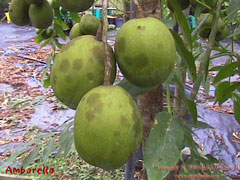The ambarella,
Spondias cytherea, is a fast-growing medium sized tree native to
the Society Islands of the South Pacific. In Florida it has been grown
for many years and is a favorite fruit of many people.
The large spreading tree can reach heights of forty to fifty feet with an equal width and it has long pinnately-compound leaves which can be from twelve to thirty inches long. The does lose its leaves for a brief period during the winter months, usually during January and February.
Clusters of tiny whitish flowers are borne in terminal clusters during March through April, and the large one-and-a-half to two-and-a-half-inch oval fruit ripen in the fall. Fruits at maturity have a yellow to golden-orange skin and an orangey-yellow pulp surrounding a single large spiny seed. Flavor varies from acid to sweet and most people eat this as a fresh fruit; however, it does make excellent preserves, jellies or sauces. In many cultures, the fruit is also eaten green before full maturity.
These grow well in a wide variety of soil types and can grow as much as four to seven feet in a single growing season. Propagation of this tree is very easily accomplished by rooting large hardwood cuttings. Superior varieties can be airlayered also. Seedlings often produce variable fruit so most people prefer to propagate ambarella by hardwood cuttings or by airlayering.
Trees are cold sensitive when small and should be protected from serious frost or freeze. Even large trees will freeze at about thirty degrees. Trees do best in full sun, but will produce some fruit in light shade, but should not be planted beneath other larger trees. If you live close to salt water, this tree has poor salt tolerance and should be be protected from the effects of salt spray.
There are few pests that affect this tree; however, on highly alkaline soils sometimes nutritional problems might require regular applications of nutrient sprays or micronutrients.
The large spreading tree can reach heights of forty to fifty feet with an equal width and it has long pinnately-compound leaves which can be from twelve to thirty inches long. The does lose its leaves for a brief period during the winter months, usually during January and February.
Clusters of tiny whitish flowers are borne in terminal clusters during March through April, and the large one-and-a-half to two-and-a-half-inch oval fruit ripen in the fall. Fruits at maturity have a yellow to golden-orange skin and an orangey-yellow pulp surrounding a single large spiny seed. Flavor varies from acid to sweet and most people eat this as a fresh fruit; however, it does make excellent preserves, jellies or sauces. In many cultures, the fruit is also eaten green before full maturity.
These grow well in a wide variety of soil types and can grow as much as four to seven feet in a single growing season. Propagation of this tree is very easily accomplished by rooting large hardwood cuttings. Superior varieties can be airlayered also. Seedlings often produce variable fruit so most people prefer to propagate ambarella by hardwood cuttings or by airlayering.
Trees are cold sensitive when small and should be protected from serious frost or freeze. Even large trees will freeze at about thirty degrees. Trees do best in full sun, but will produce some fruit in light shade, but should not be planted beneath other larger trees. If you live close to salt water, this tree has poor salt tolerance and should be be protected from the effects of salt spray.
There are few pests that affect this tree; however, on highly alkaline soils sometimes nutritional problems might require regular applications of nutrient sprays or micronutrients.
The ambarella once called
Spondias cytherea is now called Spondias
dulcis by many. Some other common names are; Vi apple, June plum,
Otaheite apple and Golden apple. Anacardiaceae, related to mango and
cashew nut.
Several varieties are developing, the most popular being a 'dwarf' which ripens fruit sometimes at less than three feet. This smaller variety fits well into almost any homescape and will produce fruit in containers. The dwarf is becoming popular in California, Florida and other areas.
Several varieties are developing, the most popular being a 'dwarf' which ripens fruit sometimes at less than three feet. This smaller variety fits well into almost any homescape and will produce fruit in containers. The dwarf is becoming popular in California, Florida and other areas.
The large spiny seed and variations
in flavor and acidity continue to be the main problems with this fruit.
